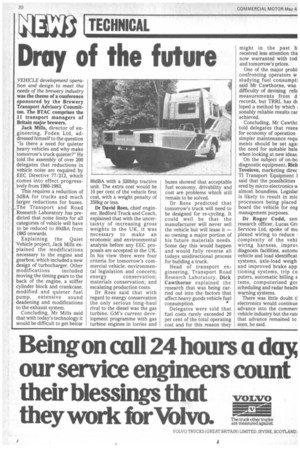Dray of the future
Page 22

If you've noticed an error in this article please click here to report it so we can fix it.
VEHICLE development operation and design to meet the needs of the brewery industry was the theme of a conference sponsored by the Brewery Transport Advisory Committee. The BTAC comprises the 11 transport managers of Britain major brewers.
Jack Mills, director of engineering, Foden Ltd, addressed himself to the question "Is there a need for quieter heavy vehicles and why make tomorrow's truck quieter?" He told the assembly of over 200 delegates that reductions in vehicle noise are required by EEC Directive 77/212, which comes into effect progressively from 1980-1983.
This requires a reduction of 3dBA for trucks and much larger reductions for buses. The Transport and Road Research Laboratory has predicted that noise limits for all categories of vehicle will have to be reduced to 80dBA from 1985 onwards.
Explaining the Quiet Vehicle project, Jack Mills explained the modifications necessary to the engine and gearbox, which included a new design of turbocharger. Other modifications included moving the timing gears to the back of the engine, a stiffer cylinder block and crankcase, modified and quieter fuel pump, extensive sound deadening and modifications to the exhaust system.
Concluding, Mr Mills said that with today's technology it would be difficult to get below 80dBA with a 320bhp tractive unit. The extra cost would be 10 per cent of the vehicle first cost, with a weight penalty of 250kg or less.
Dr David Rees, chief engineer, Bedford Truck and Coach, explained that with the uncertainty of increasing gross weights in the UK, it was necessary to make an economic and environmental analysis before any EEC proposals are accepted in the UK. In his view there were four criteria for tomorrow's commercial vehicle: environmental legislation and concern; energy conservation; materials conservation; and escalating production costs.
Dr Rees said that with regard to energy conservation the only serious long-haul rival to the diesel was the gas turbine. GM's current development programme with gas turbine engines in lorries and buses showed that acceptable fuel economy, drivability and cost are problems which still remain to be solved.
Dr Rees predicted that tomorrow's truck will need to be designed for re-cycling. It could well be that the manufacturer will never sell the vehicle but will lease it — so owning a major portion of his future materials needs. Some day this would happen and would fully reverse all todays unidirectional process for building a truck.
Head of transport engineering, Transport Road Research Laboratory, Dick Cawthorne explained the research that was being carried out into the factors that affect heavy goods vehicle fuel • consumption.
Delegates were told that fuel costs rarely exceeded 20 per cent of the total operating cost and for this reason they might in the past h received less attention tha now warranted with tod and tomorrow's prices.
One of the major probli confronting operators w studying fuel consumpti said Mr Cawthorne, was difficulty of devising relii measurements from d records, but TRRL has d( loped a method by which sonably reliable results car achieved.
Concluding, Mr Cawthc told delegates that resea for economy of operation simpler maintenance requ ments should be set aga] the need for suitable bala when looking at new ideas.
On the subject of on-be diagnostic equipment, Rich Tovelove, marketing direc TI Transport Equipment I said that the possibilities ered by micro-electronics vv almost boundless. Legislat is likely to result in mic processors being placed board the vehicle for eng management purposes.
Dr Roger Codd, sen research officer, Lucas Gr.( Services Ltd, spoke of mu plexed wiring to reduce complexity of the vehi wiring harness, improN diagnosis facilities, automi vehicle and load identificat systems, axle-load weigh and improved brake app tioning systems, trip co puters, automatic billing s tems, computerised go( scheduling and radar heady; warning systems.
There was little doubt ti electronics would continue advance into the commer( vehicle industry but the rat( that advance remained to seen, he said.
























































































































